On November 2, high above Nogales, Sonora at the Colinas del Buen Pastor cemetery, Taide Elena placed two lit candles on the grave of her grandson, 16-year-old José Antonio Elena Rodríguez.
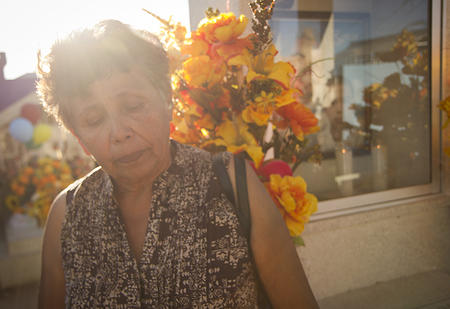
“Era mi niño,” she said over and over again through tears. He was my boy. He was my boy.
Colinas del Buen Pastor was teeming with people this Day of the Dead. Several families had hired Banda and Norteño musicians to play at their burial plots. Multiple generations sat together around memorials— drinking, eating, laughing, and remembering. But Elena, mourning a death just three weeks past, came alone, left her ofrenda, or offering, cried, and walked away. The tears soon stopped but the shell-shocked expression of someone slowly working through a sudden and inexplicable tragedy held on longer. Later on that evening, you could still it in the long stares of her large, expressive eyes.
Walking to her car, Elena shared a memory of her grandson, who had been living at his grandparents’ house, just a few blocks south of where he died, for several years since the death of his father and his mother’s decision shortly thereafter to move to Navojoa, Sonora to look for work.
“What I miss most about him is that he always greeted me with a hug and a kiss when he came home,” she said. “He was very loving.”
Elena was heading back toward the port of entry, where people were starting to gather on both sides of the border for the first binational march protesting the death of her grandson. On the evening of October 10, a border patrol agent shot and killed José Antonio, who was approaching the end of his secondary education when he died. The incident is still under investigation.
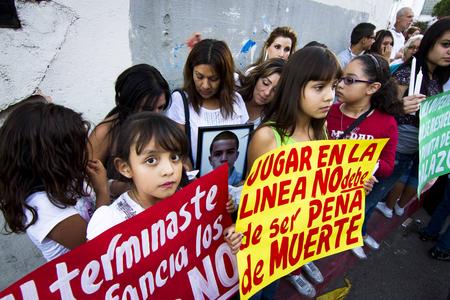
According to Border Patrol’s account, on the evening of the killing, around 11:30 pm agents were responding to a report of drug smuggling near the U.S.-Mexico border and were assaulted with rocks being thrown from the Mexican side. After issuing repeated commands to stop, one agent responded by opening fire on the rock throwers, as is allowed by agency use of force policy. According to an October 17 report in the Arizona Daily Star, the agent who shot José Antonio would have had to be right at the fence to shoot through the four-inch gaps without risking ricochet.
In an interview with the Arizona Star for the same story, Art Del Cueto, president of the National Border Patrol Council local representing Tucson Sector agents, defended the agency’s use of force policy saying, “[r]ocks can kill you. That’s what it comes down to. When you’re getting rocked, and you don’t know if you’re going to make it home, it’s a split-second decision.” While rock throwing does happen along the border, no Border Patrol agent has ever been killed by a rock.
A report filed by two Nogales Police Department officers who were on scene throughout the incident corroborates some of the story, but calls other parts into question. Officers John Zuniga and Quinardo Garcia both report seeing rocks being thrown, but neither officer heard any Border Patrol agent issue a warning before opening fire.
In the eyes of his family, José Antonio was simply at the wrong place at the wrong time. His older brother works at a nearby Oxxo, a Mexican convenience store chain, and got off work around midnight. Luis Parra, one of the lawyers representing the family on the U.S. side, has said that it could be the case that José Antonio was just on his way to help his brother close at the end of shift as he had done before.
While there is very little certainty about the details of the case, what is known is that at least seven of the bullets fired that evening hit José Antonio and ended his life on the sidewalk near the corner of Ingenieros and Internacional. The bloodstains have all but faded and the memorial that once marked the spot is gone entirely. Now it is just his family fighting for justice, as well as allies on both sides of the border, keeping his memory alive.
Many people question the official story, with most focusing on the apparent disproportionality of rocks and bullets, and on the geography at the site of the shooting. Unlike most parts of the border wall just west of downtown Nogales, the section of wall near the shooting is on top of a 15-20 foot cliff and its base is covered by dense brush, all of which makes throwing rocks to the other side a challenge.
Charles Rooney, a 73-year-old Tucson resident, is one of several dozen protestors making the hour-long drive south for Friday’s march from downtown Nogales to the border wall half a mile west. He had the same reaction as many when he first saw the scene of the shooting. “When I went down to the bottom of the hill where the shooting took place I said, ‘there’s no way in the world that anyone would worry that they were going to get hit by a rock and hurt’,” he explained. “You’d have to be Justin Verlander to have the arm power to be able to throw a rock up that high and damage someone.”
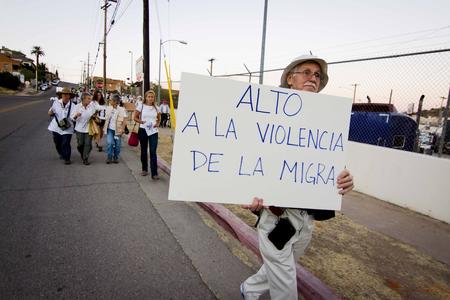
José Antonio’s killing was just the latest in a string of recent Border Patrol shooting deaths. According to the Southern Border Communities Coalition, there have been four agent-involved killings in the last two months, including Border Patrol agent Nicholas Ivie, and 19 since 2010. Though Border Patrol was not involved, a state trooper shot and killed two undocumented Guatemalan migrants riding in the bed of a truck from a helicopter near La Joya, Texas two weeks after José Antonio’s death. The killings only added to the growing tension along the border.
The unsettling circumstances of José Antonio’s death, combined with the recent violent history of border enforcement, provoked a moving binational reaction on the evening of November 2, Day of the Dead. Though divided by the border wall, the common call for justice and profound changes in Border Patrol's use of force policy united the nearly 100 people on each side. Tucson-based migrant advocacy groups No More Deaths and Derechos Humanos organized the U.S.-side of the march, and the Home of Hope and Peace (HEPAC) and the family of José Antonio organized the Sonoran, Mexico side.
Guadalupe Barrios, a 25-year-old Tucson resident who said he almost had to quit his job to make it to Nogales, expressed the exasperation shared by many at the procession. “We’re marching because we’ve had enough. Enough of the abuse of authority, enough of the harassment of our communities, enough with all of the abuse being done,” he said. “This is somebody’s child that was killed. There’s a family mourning for him. It’s not something that’s uncommon. It’s not something that’s being stopped. So we have to bring attention to it, we have to raise awareness. We’re all the same. There’s no difference. We’re all people.”
Each group marched to the site of the shooting and then met at the wall several blocks west for a vigil and cross-border exchange of flowers, songs, and testimonies. Strangely absent from the scene were the Border Patrol trucks that are usually parked at tight, regular intervals along the border. Whatever the agency’s motivation was behind pulling their agents that evening, it was striking to see the normally militarized space, if only for one night, become one in which love and solidarity moved back and forth through the bars so freely.
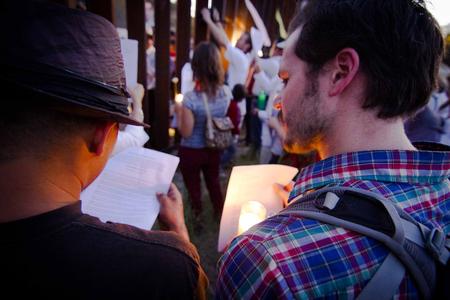
Before the march began, Elena, who was able to march on the U.S. side because she is a legal permanent resident, said that she was moved by the level of binational support. “I thank all of the people participating on the other side, and on this side,” she said. “They are helping so that justice is done. I am very grateful. I hope that they continue helping us because we don’t know what’s going to happen next.”
When marchers on the U.S. side arrived at the meeting point, a chant of "¡no más muertes!’ or "no more deaths," took hold. Many passed white flowers and kind words through the wall to Araceli Rodríguez, José Antonio’s mother. They passed candles back and forth, with some reaching lighters and matches through to help their fellow marchers light them.
One of the most powerful exchanges came when Guadalupe Guerrero offered her condolences to Araceli Rodríguez through the border wall’s bars. Guerrero is the mother of Carlos Lamadrid, another youth killed by Border Patrol in March of 2011. Lamadrid, a U.S. citizen who was unarmed at the time of the incident, was allegedly smuggling marijuana and was shot in the back twice and in the thigh once as he tried to climb over the wall into Mexico.
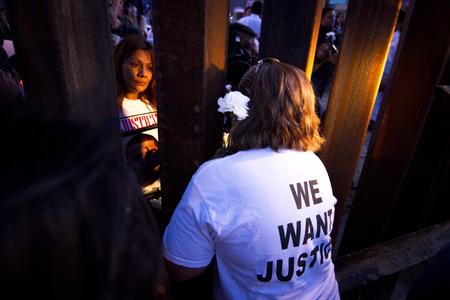
Jeannette Pasos Gonzalez, director of the Home of Hope and Peace (HEPAC), and one of the organizers of the event on the Mexican side, said that justice for José Antonio and other border communities requires hard work on both sides of the border. “This case should not be swept under the rug,” she said. “Now, with a binational lens, what we want to do is raise consciousness and sensitivity in both countries. We believe that this message has to get to Washington, the message that these kinds of deaths can’t happen, least of all to children.”
There is already some movement in this direction. In response to congressional outcry about the 2010 death of Anastasio Hernandez while in Border Patrol custody, the brutal circumstances of which were recently revealed by the PBS documentary “Crossing the Line,” the Office of Inspector General (OIG) recently announced that it would conduct a review of Border Patrol use of force policy and accusations of brutality.
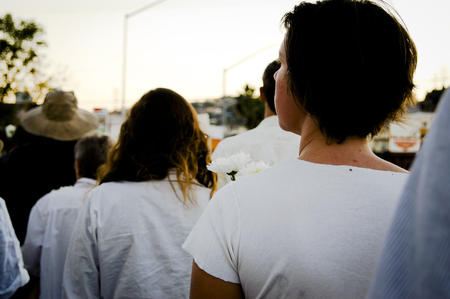
But No More Deaths volunteer and event organizer Molly Little thinks that that is not nearly enough. OIG, like Border Patrol, is a part of the Department of Homeland Security and Little, who participated in No More Deaths’ Border Patrol abuse documentation project, has plenty of reason to doubt the ability of DHS to investigate itself. Beyond calling for a transparent investigation of José Antonio’s death and the release of the video of the incident captured by a nearby camera tower, Little and others are demanding legitimate mechanisms for preventing similar shootings in the future. “When this most recent murder happened, we saw it in this broader context of cruelty and impunity in the Border Patrol,” she said. “What we need more broadly is an independent oversight body, comprised of human rights groups, impacted members of border communities, to investigate the culture of impunity in the Border Patrol.”
Mike, a 66-year-old resident of Tubac, AZ who declined to give his last name, cited the same lack of community control over the Border Patrol when asked why he participated in Friday’s march. “There should be a lot more outrage because an innocent child was murdered and shot down. We’re sorry, obviously. It’s a horrible thing,” he said. “But how can you apologize for something we have very little control over?”
When asked what he’d like to see happen in the long term, he took it a step further.
“I’d like to see the fence come down,” he said.
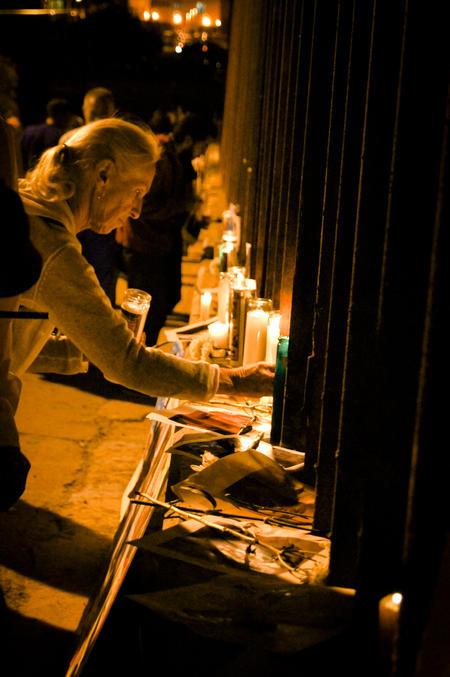
Murphy Woodhouse is an MA student at the University of Arizona's Center for Latin American Studies. His research interests include migration, deportation, U.S. immigration enforcement, and the Mexican drug war.

